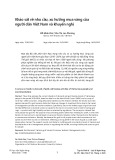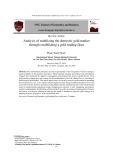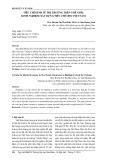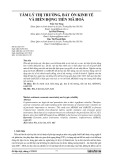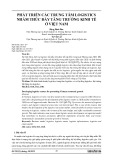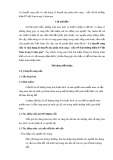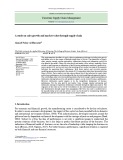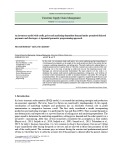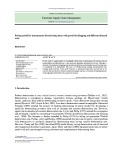
* Corresponding author
E-mail address: nitahshah@gmail.com (N. Shah)
© 2019 by the authors; licensee Growing Science, Canada
doi: 10.5267/j.uscm.2018.12.003
Uncertain Supply Chain Management 7 (2019) 439–456
Contents lists available at GrowingScience
Uncertain Supply Chain Management
homepage: www.GrowingScience.com/uscm
Optimal replenishment and pricing policies for deteriorating items with quadratic
demand under trade credit, quantity discounts and cash discounts
Nita Shaha* and Monika Naika
aDepartment of Mathematics, Gujarat University, India
C H R O N I C L E A B S T R A C T
Article history:
Received February 7, 2018
Accepted December 6 2018
Available online
December 6 2018
Trade credit mainly signifies increase in order quantity when retailer offers a trade credit to the
customer. From the customer’s view, granting trade credit not only increases sales and revenue
but also increases opportunity cost. So, the choice to offer trade credit is an important managerial
consideration. Moreover another significant decision on purchasing is to include (or not to
include) cash discount benefits and the motivations behind it. Therefore, the major objective of
this article is to derive the inventory models for deteriorating items by maximizing the total profit
of the retailer. The models includes the cash discount for the retailer depending on ordering
quantity and also cash discount for the customer depending on the time. The customer’s demand
is expressed as a function of time and price, which is appropriate for the products for which
demand increases initially and after sometime it starts to decrease. Lastly, numerical examples
along with sensitivity analysis are done, which extracts some fruitful managerial insights.
ensee Growin
g
Science, Canada
by
the authors; lic9© 201
Keywords:
Trade credit
Quantity discounts
Cash discounts
Deteriorating items
Time-price dependent demand
rate
1. Introduction
In various inventory systems, the deterioration in products like fruits, vegetables, medicines etc. is
normally observed, leading in excessive damages in quality as well as quantity of items. In order to
raise the market demand many policies like trade credit, quantity discounts, cash discounts representing
all forms of demand enhancing efforts. Many literature works on inventory control are demonstrated
on the basis of assuming fixed rate of demand over entire inventory cycle. Even though, in real-life
situations, there are many aspects affecting the rate of demand such as the price associated with selling
of the items and the obtainability of items. On the basis of facts, the models dealing with inventory
includes demand rates based on selling price of items are considered by decreasing price increases sales
of many products.
The rate of market demand is assumed to fluctuate as a function, based on level of stock, the price value
or together, in models on inventory with rates of demand as variable one. For deteriorating of items
with the concept of partial back-logging and with a level of stock based rate of demand, and a bound
on the extreme level of inventory, a model on inventory was represented by Min and Zhou (2009).
Other model on inventory with rate of demand based on level of stock for items which are deteriorating
in nature was proposed by Yang et al. (2010), permitting back-logging partially and including the

440
inflation effect. An EOQ concept consisting of back-logging partially, in which the rate of demand is
based on level of stock, and a manageable rate of deterioration determines the strategies of preservation
and lot order size in optimum manner to rise the total profit to maximum, was formulated by Lee et. al.
(2012).
Firstly, Silver et al. (1969) have attempted for time varying demand rate, then after many scholars
named Silver (1979), Chung et al. (1993, 1994), Bose et al.(1995), Hariga (1995), Lin et al. (2000),
Mehta et al. (2003, 2004), Shah et al. (2009), and Shah et al. (2014) have expressed rate of demand as
time varying in terms of linear, exponential or quadratic, etc. in nature. Moreover, practically, to
increase order quantity, supplier offers a trade credit to the retailer. From the retailer’s view, granting
trade credit not only increases sales and revenue but also increases opportunity cost. Initially, an
inventory model with the permissible delay in payments was introduced by Haley and Higgins (1973).
Kingsman (1983) highlighted the effects of various means of payment on stocking and ordering. An
EOQ model was proposed by Goyal (1985) along with permissible delay in payments, with interest
earned and paid. Aggarwal and Jaggi (1995) including deteriorating items modified Goyal’s (1985)
model. A Fuzzy EPQ model for deteriorating items was presented by Mahata and Goswami (2006)
with allowable delay in payment. The concept of time-dependent demand and time-varying holding
cost under partial backlogging was included in Mishra’s et al. (2013) inventory model for deteriorating
item. On the other hand, by expressing demand as a function of price and with considering the
difference between the purchase cost and selling price, Teng et al. (2005) estimated the lot size and
optimal price under allowable delay in payments. With the concept of permissible delay in payments,
Shah and Shah (1998) proposed a probabilistic EOQ inventory model for deteriorating items
considering demand is a random variable and time and deterioration of units as continuous variables.
Lin et al. (2012) developed a united supplier-retailer inventory model with trade credit policy and
allowing defective items by calculating optimal ordering and delivery policy. Many other significant
articles related to trade credit such as Mahata and Goswami (2007), Arcelus et al. (2003), Jamal et al.
(2000), Abad and Jaggi (2003), Chang (2004), Chung (2004) etc.
The listed above all inventory models assumes one-level trade credit. Nowadays, more and more efforts
are drawn in raising the collective advantage by constructing coordinated model for both players rather
than individual one in supply chain. According to the assumption, a delay period is offered by supplier
to retailer, and within the trade credit period, the retailer could sell the goods and accumulate revenue
and earn interest. But to enhance the customer’s demand rate and to cutoff the on-hand stock cost,
customer should also be offered a trade credit period by retailer. So, the supplier offers a credit period
to the retailer and the retailer, offers the credit period to his/her customers. To stimulate the demand,
Huang (2003) proposed an inventory model with an assumption that the retailer also permits a credit
period to its customer which is shorter than the credit period offered by the supplier. Huang (2006)
modified Huang (2003) model under two levels of trade credit and limited storage space to estimate the
retailer’s inventory policy. An inventory model for deteriorating items under two-level trade credit
policy in fuzzy sense is proposed by Mahata and Goswami (2007) to determine an optimal ordering
policy. Huang (2006) generalized Huang (2003) by developing an EPQ model to estimate the two-level
trade credit policy. A fuzzy economic order quantity model for deteriorating items was proposed by
Mahata and Mahata (2011) under retailer partial trade credit financing in a supply chain. An EPQ model
was presented by Mahata (2012) for deteriorating items under retailer partial trade credit policy. Kreng
and Tan (2010) altered Huang (2003) by presenting an EOQ model under two levels of trade credit
policy depending on the order quantity by developing optimal wholesaler’s replenishment decisions. A
joint supplier buyer inventory model was proposed by Ho et al. (2008) with the assumption that demand
is sensitive to retail price and the supplier adopts a two-part trade credit policy.
Hill and Riener (1979) constructed an inventory model to estimate the cash discount in the firm’s cash
credit policy, by including trade credit and firm’s cash discount. An EOQ model with cash discount
and trade credit is developed by Huang and Chung (2003). An optimal ordering policy was derived by

N. Shah and M. Naik / Uncertain Supply Chain Management 7 (2019)
441
Chang and Teng (2004) for a retailer with deteriorating item, in the case when supplier provides a cash
discount as well as permissible delays to avoid default risks and to increase sales respectively. Dolan
(1987) derived an inventory model including the concept of quantity discounts. Chung et al. (2017),
proposed an inventory model with constant demand combining the concept of trade credit and quantity
discounts. Another literature reviews on inventory modelling with trade credit and price discounts were
demonstrated by Ouyang et al. (2005), Huang and Hsu (2007), Sana and Chaudhuri (2008), Ho et al.
(2008), Yang (2010).
The main objective of this article is to maximize total profit by synchronizing various concepts like,
two levels of trade credit, cash discount and quantity discount for deteriorating items with market
demand depending on selling price and time and to construct a unique inventory model when the cash
discount for the retailer depends on the ordering quantity and cash discount for the customer depends
on the time when customer buys item. The variable demand comprising of combination of all above
stated concepts for deteriorating products make this article a unique one. At last, to validate the derived
models, numerical examples along with sensitivity analysis are undertaken, which extracts some
fruitful managerial insights.
The organization of this article is consisting of the six sections stated as; section 2 represents the
notations and assumptions. The model is introduced in section 3. Section 4, deals with the solution
methodology adopted in this paper, also classical optimization technique is utilized to acquire the
optimal policy. Section 5 consists of conducting numerical analysis and sensitivity analysis about the
inventory parameters. Lastly, conclusion of the study is represented in section 6.
2. Notations and assumptions
2.1. Notations
(, )Dt t p Demand rate per unit at any time t and at any price
p
A Fixed ordering cost (Dollar/order)
C Unit purchasing price (in Dollars)
h Unit inventory holding cost/year excluding interest charges
e
I
Annual interest earned (in Dollars)
c
I
Annual interest charged (in Dollars)
The constant deterioration rate
i
M
th
ipermissible delay period
0,1, 2i
1
d Cash discount rate offered by the supplier
2
d Cash discount rate offered by the retailer
1
Q The quantity at which the supplier provides the cash discount rate 1
d to the retailer
Decision variables
T Replenishment cycle length
p
Unit selling price (in Dollars)
, TP T p The total profit in each period (in Dollars)
*
Q Optimum order size
2.2 Assumptions
1. Infinite time horizon is considered.
2. Shortages are impermissible.

442
3. Let the demand rate for the item be 2
(, ) (1 )Dt t p a bt ct p
, a function of time; with
p
as the
selling price of customer per unit, where, 0ais a scale demand, 01b
denotes the linear
rate of change of demand with respect to time, 01c
denotes the quadratic rate of change of
demand and
is the mark up for selling price, where, 1
.
4. Instantaneous replenishments are considered.
5. 012
M
MM.
6. 1
01d
.
7. 2
01d
.
8.
2
1.dpC
.
9. - The supplier offers a cash discount rate 2
d to the retailer for the ordering quantity
1
QQ; and at time 0, the retailer will settle the account and start paying for the interest
charged on the items in stock with rate c
I
.
- For the case, 1
QQ the retailer will have the trade credit period 0
M
. While the period when
the account is not settled, the generated sales revenue is deposited in an interest-bearing
account with the rate e
I
. At the completion of this period, the account is settled and the
retailer starts paying for the interest charged on the items in stock with rate c
I
.
10. A customer gains a cash discount rate 1
dby retailer and makes payment at time period twhen
the customer buys an item from the retailer at time
2
0,tM. Moreover, a customer enjoys a
trade credit period 1
M
t and makes the payment at time 1
M
, when the customer buys an item
from the retailer at time
21
,tMM.
11. For the utilization of other activities, the retailer retains the profit.
3. Mathematical model formulation
Let
0,T be the period of replenishment cycle where a firm tends to sell a single product, which is
deteriorating in nature. The firm regulates the selling price
p
with time period t to fluctuate market
demand (,)Dt p t . Let the process of deterioration of product begins with the entry of the item in the
system. The inventory deterioration is directly proportional to the level of inventory. ..()ie I t
For the
period of scheduling horizon
0,T, the level of inventory declines due to the collective influences of
rate of market demand, and the inventory level at the end of replenishment cycle reaches zero. This
inventory level scenario can be represented by the differential equation (1), with boundary condition,
() 0IT
() () ( ,) ,0
dI t It Dtpt t T
dt
(1)
Equation (1) demonstrates that the level of inventory sustains non-negative nature for all time,
.. 0, , () 0ie forallt T I t
without backordering throughout the scheduling horizon. On solving
equation (1) with the boundary condition () 0IT
, the level of inventory at any time t is demonstrated
as in Eq. (2),

N. Shah and M. Naik / Uncertain Supply Chain Management 7 (2019)
443
22 2 2
3
22 2 2
3
22
()
22
Tt
p a ct bt ct b c
It
p a cT bT cT b c e
(2)
The optimal ordered quantity is derived as stated below:
2
3
22 2 2
3
2
*0
22
T
pa b c
QI
pa cT bT cT b ce
(3)
Let 1
1
0
(,)
T
Qt
Dt p t dt
.
There are following four cases that occurs in this inventory problem:
1. 1
210
0
0;
T
Q
MMM
Dtdt
2. 1
21 0
0
0;
T
Q
M
MM
Dtdt
3. 1
210
0
0;
T
Q
M
MM
Dtdt
4. 1
210
0
0.
T
Q
M
MM
Dtdt
Case 1. 1
210
0
0;
T
Q
MMM
Dtdt
The total profit of the system is computed with the following components:
1. Sales revenue: The sales revenue per unit time is given by,
0
0
2
(,) [(1 ) ]
T
T
pC Dtptdt
p
Ca btct p dt
SR TT
(4)
2. Holding cost: Suppose with the positive holding cost co-efficient h, the holding cost function
per unit time is given by,
22 2 2
3
22 2 2
0
3
0
22
.
22
.()
T
T
Tt
p a ct bt ct b c
hdt
pa cT bT cT b c e
hItdt
HC TT
(5)
3. Ordering cost: The ordering cost per unit time, with
A
, as order cost per order is given by,
A
OC T
(6)

